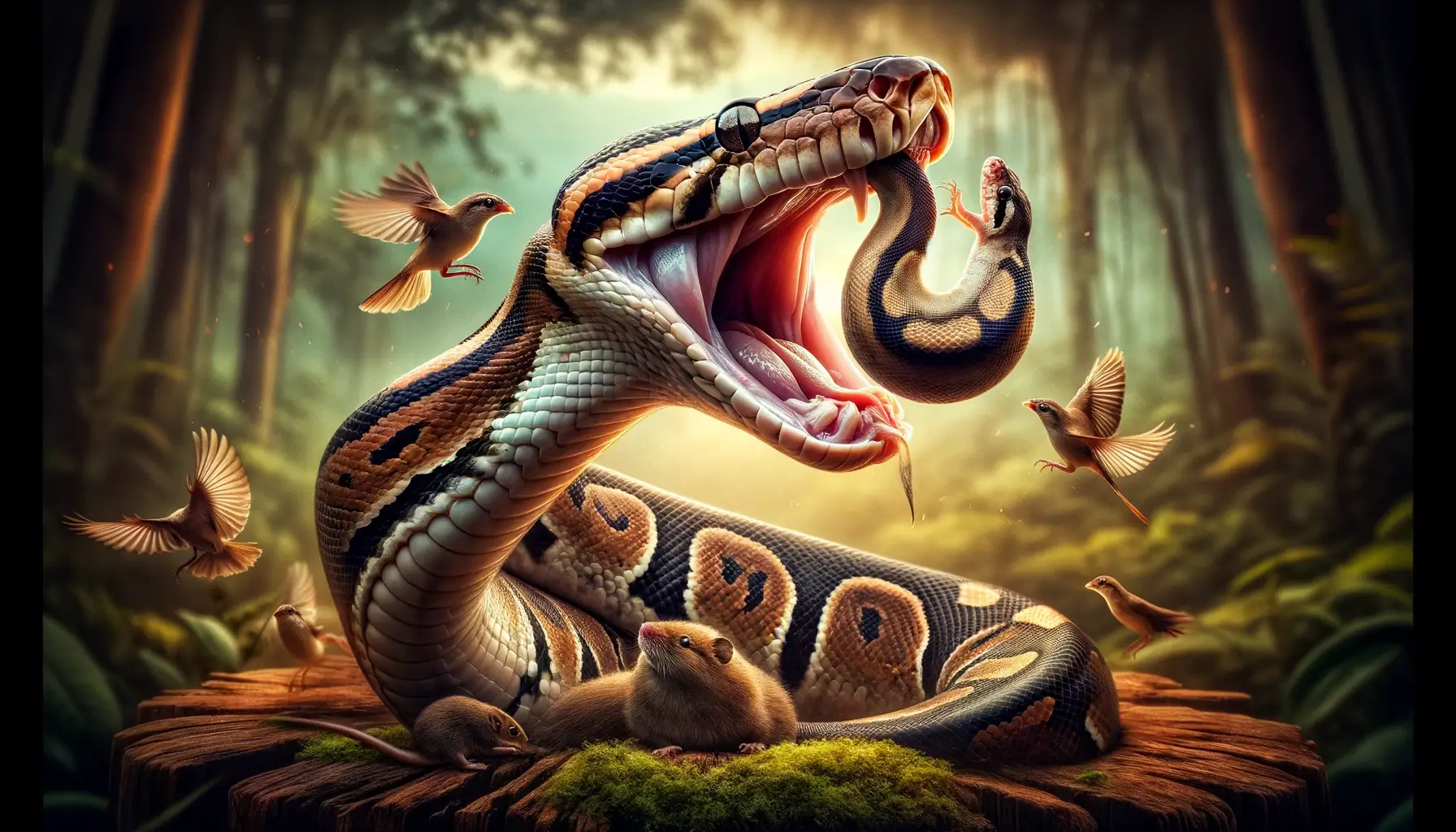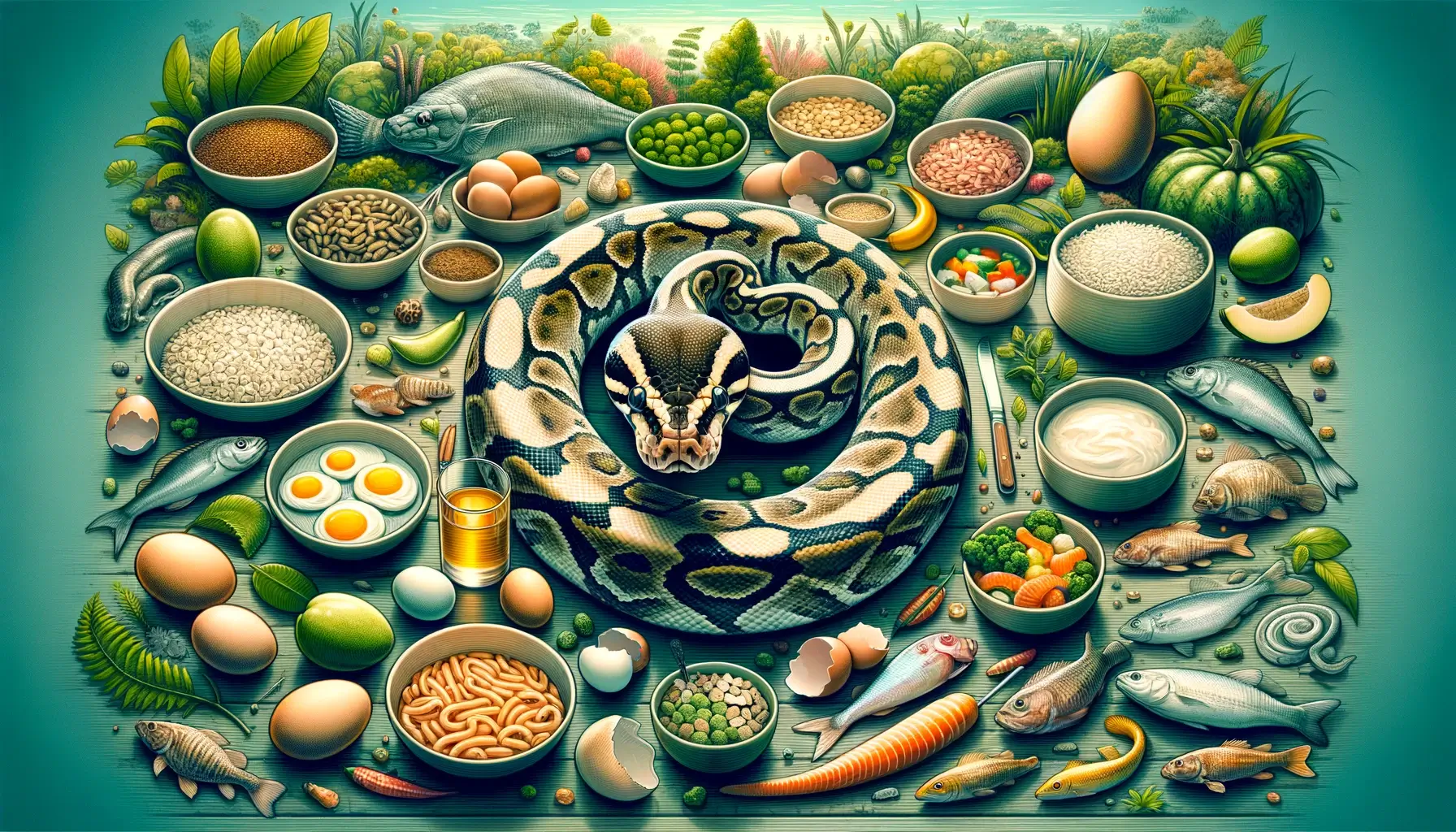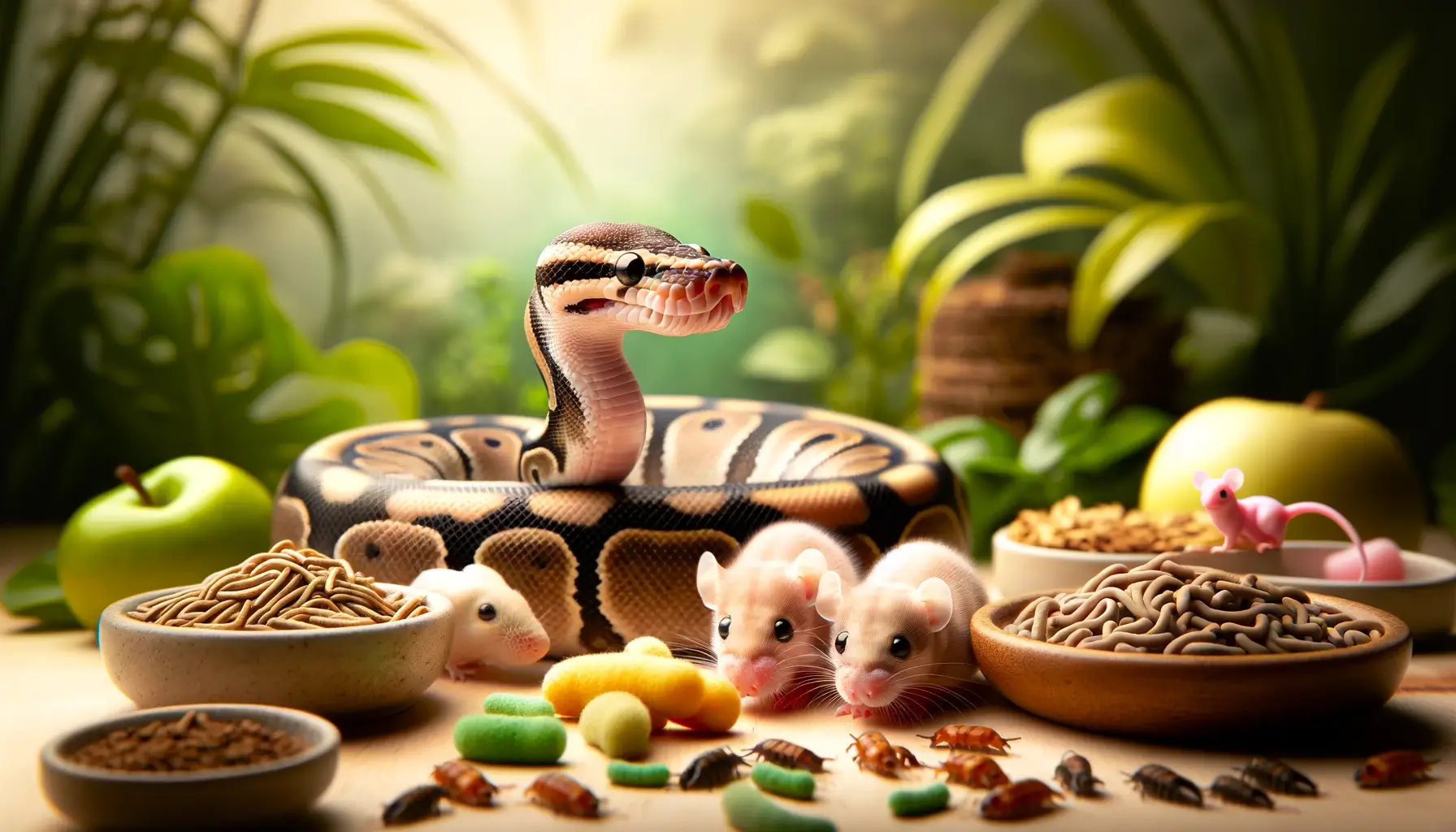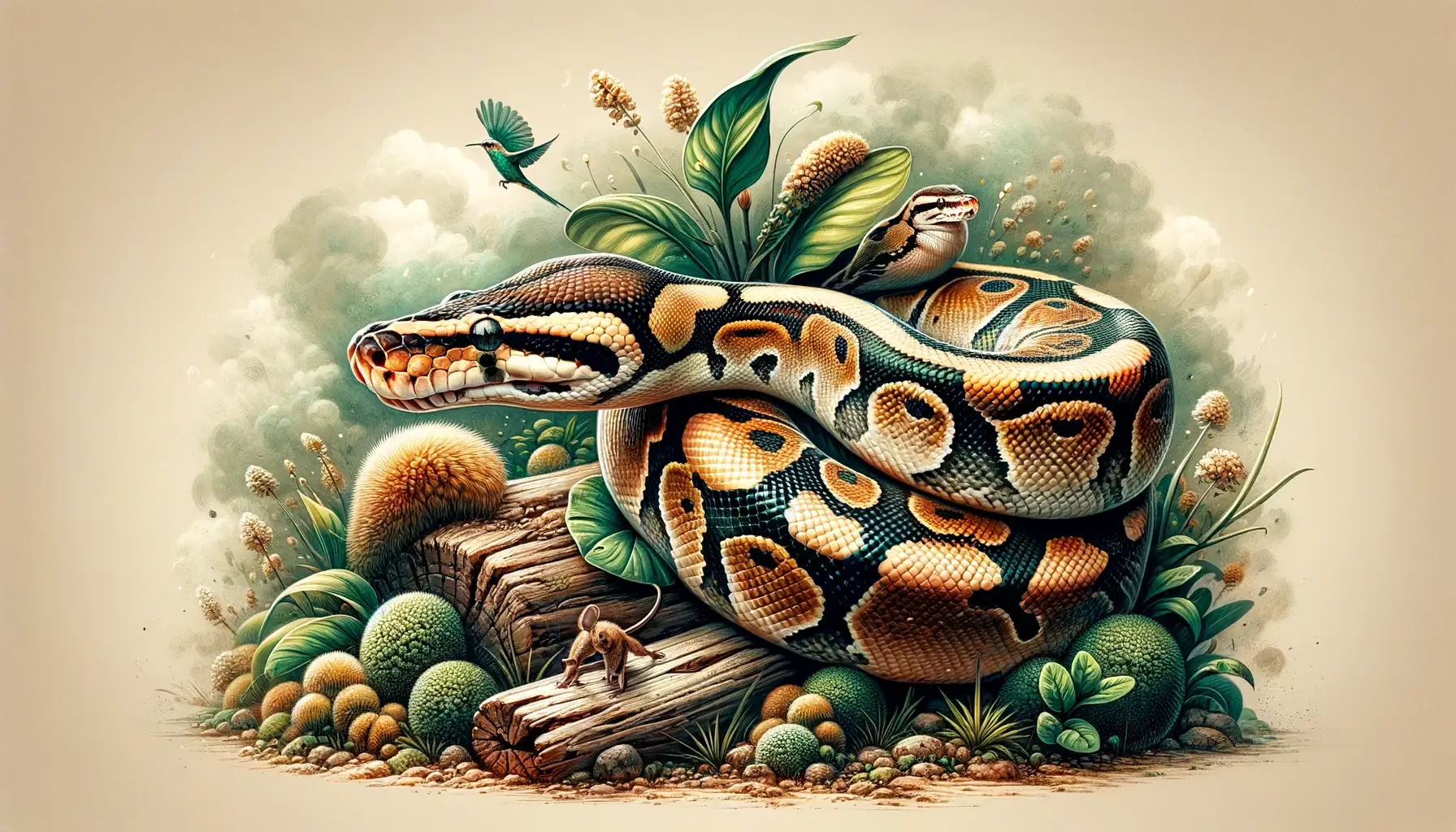Did you know that ball pythons, despite their small size, can consume prey larger than their head due to their stretchy skin and flexible jaws? As a ball python owner, you must be familiar with their dietary needs, which are quite different from other pets. They mainly eat rodents, but can they eat anything else? And how often should you feed them? Finding the answers to these questions isn’t just important; it’s essential to your pet’s health. Stay with us as we unravel the mystery of a ball python’s diet.

Understanding Ball Python’s Dietary Basics
What exactly does a ball python eat, you might wonder? Well, understanding a ball python’s dietary basics is the first step to ensuring its health and longevity. Primarily, a ball python diet consists of rodents. But what can ball pythons eat besides rodents?
Well, in nature, they’re known to consume small mammals and birds, but in captivity, they usually feast on rodents like mice and rats. A diet of pre-killed, frozen, then-thawed rodents is the safest and most recommended for captive snakes. This method minimizes the risk of injury to the snake, as live prey can bite back.
Now, you’ll also be curious about what ball pythons eat in terms of size. Here’s a simple rule: The width of the prey should not exceed the widest part of your python. This prevents complications like choking or digestive issues.
Lastly, remember that freedom is a fundamental part of their existence, even in captivity. Freedom to thrive, to hunt, to grow. So, ensuring a balanced diet, mimicking their natural food sources is your best bet to ensuring your ball python’s health and happiness.
Common Prey Items for Ball Pythons
Building on the basic understanding of a ball python’s diet, it’s essential to delve deeper into the specifics of their most common prey items in captivity. You may wonder, what can ball pythons eat? The answer is a variety of prey items, but the most common are mice and rats. However, what can ball pythons eat besides mice and rats?
Birds: Young chicks and quails can be an occasional treat. Their different nutritional content adds variety, which can evoke feelings of freedom in your python’s dietary routine.
Gerbils and Hamsters: These animals can diversify your ball python’s diet, but they should not form the staple snake food due to their high-fat content.
Amphibians: Frogs and toads, while rarely used, can be an alternative prey item.
The Importance of Feeding Rodents
While a diverse diet can be beneficial, feeding your ball python rodents like mice and rats is crucial for their overall health and wellbeing. Rodents are a primary source of protein and fat, which are key to a ball python’s growth and development. So, what else can ball pythons eat? While insects, amphibians, and birds can supplement their diet, rodents should make up the majority of their meals.
You might wonder, what can baby ball pythons eat? Baby snakes require smaller prey, typically baby rodents or ‘pinkies.’ A ball python feeding chart can be a useful tool to guide you, but generally, they should consume a rodent of a size that leaves a noticeable bulge in their body every 1-2 weeks.
Now, how often do snakes eat? This depends on factors like age, size, and health. Younger, growing pythons may eat more frequently, while adults may eat less. Be mindful of overfeeding, as it can lead to obesity and health issues.
Alternative Food Options for Pythons
Beyond the staple diet of rodents, there are alternative food options you can consider to enrich your ball python’s nutritional intake. Now, you may be wondering, “what does a snake eat besides rodents?” Well, let’s dive into the scientific details of alternative food options for pythons.

Fish: You could ask, “What kind of fish can ball pythons eat?” The answer is quite simple. Pythons can eat fish like guppies, goldfish, and plates. However, remember that fish should only make up a small portion of their diet, as they don’t provide all the necessary nutrients.
Birds: Small birds are also a valid option. They provide a diverse nutrient profile, which is beneficial for your python’s health.
Amphibians: Frogs and toads can also be part of your python’s diet.
Take note, however, that these are not the only foods your snakes eat. Ball pythons are opportunistic eaters in the wild, which means they’ll eat what they find. But in captivity, maintaining a balanced diet is crucial for their health. You have the freedom to experiment, but always prioritize your python’s nutritional needs.
Diet Variations for Baby Ball Pythons
When it comes to baby ball pythons, their diet requires careful consideration and a different approach compared to adult pythons. As a python snake pet owner, you must understand that the ball python size plays a crucial role in determining its diet.

At birth, your ball python pet is about 10 inches long and should be fed pinkie mice, which are newborn mice that haven’t developed fur yet. As your python grows, you can gradually introduce fuzzies, which are slightly older mice with a bit of fur. It’s essential to adjust their diet in accordance with their growth.
Remember, overfeeding can lead to obesity and other health issues. On the contrary, underfeeding or allowing your python to go for prolonged periods without food can be equally detrimental. To put it into perspective, a baby ball python can go without eating for about a week, but this isn’t ideal.
Caring for a ball python involves regular health checks and maintaining a feeding schedule. It can be a rewarding experience if you get the diet right. The key is to understand their needs, respect their freedom, and provide a diet proportionate to their size.
Can Ball Pythons Eat Fish?
You may wonder if your ball python can eat fish, given the diversity of foods other snake species can consume. However, it’s crucial to understand that fish aren’t typically part of a ball python’s diet. These snakes prefer a diet consisting of small mammals, like mice and rats.
Here’s why fish might not be the best choice for your python:
- Ball pythons are not naturally predisposed to consuming fish. They’re equipped to handle warm-blooded prey, which has a different nutritional profile than fish.
- The question of “How big do ball pythons get?” is tied to their diet. Providing an inappropriate diet can hamper their growth.
- “Do ball pythons bite?” Yes, they can, especially when stressed. An unexpected diet change to fish may cause stress, leading to potential biting.
You might also be curious about “how long can a snake go without eating,” or, more specifically, “how long can ball pythons go without eating.” Ball pythons can survive without food for many weeks, but it’s crucial to maintain a consistent, species-appropriate feeding schedule for their health and wellbeing.
Useful Tips for Feeding Your Python
Navigating the feeding routine of your ball python can be a daunting task, but with the right knowledge and tips, it’s easier to ensure their dietary needs are met. Understanding how long ball pythons live, typically around 30 years, can help you comprehend the long-term commitment of proper feeding.
Ball pythons, often considered small pet snakes, require a diet primarily of rodents. When your snake is fully grown, an adult ball python can comfortably consume a medium-sized rat. It’s crucial to adjust the size of the prey to the size of your python. As a rule of thumb, the prey should not be wider than the widest part of your python.
Monitor how big your ball python gets. Overfeeding can lead to obesity, a common issue in captive snakes. Underfeeding, on the other hand, can stunt growth and lead to other health issues.

